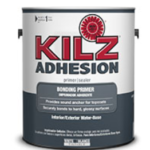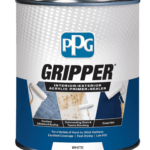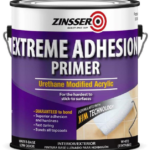
Have you ever been confused about the different types of materials used to make furniture and why there is a price differential? I know I have, and I am in the home décor business! When I first started buying furniture to paint, I had no idea the difference between solid wood, veneer, and laminate furniture. But thanks to my dear husband (DH), who is a big fan of solid wood by the way, he started teaching me the differences.
Even though DH prefers solid wood, there are other options especially when cost is a factor. When buying a piece of furniture also consider how you will be using the piece and for how long. In this article on how to paint laminate furniture, I’ll explore the meaning of laminate and its pros and cons.
What is Laminate?
Laminate is a man-made product that is printed to look like it has wood grain allowing manufacturers to create furniture, cabinets, and floors for less money. Laminate furniture is made up of synthetic materials (typically plastic) used to form a thin layer that looks like wood.
The wood grain appearance of laminate is achieved through a printed process. After being printed, the sheets are attached to a durable core material, such as MDF — medium-density fiber. Laminate pieces often have a shiny finish and look manufactured.
Laminate is a manufactured product made to resist heat and scratches. This fact makes laminate a good choice over other types of furniture for busy areas of a house or when the furniture might get a lot of heavy use (i.e. the kid’s rooms).
Even though the finish might be just as durable as if it were applied onto wood, laminate furniture is typically poorly built and isn’t as heavy-duty as a solid wood piece. However, next time you see a piece of laminate furniture at a good price, you should consider it as a piece to paint.
Pros of Laminate
Even though laminate is not real wood, there are some potentially good qualities that might fit your needs. Here are a few of the positives of choosing laminate furniture:
- Cost. Laminate is generally the least expensive of all the furniture types. If cost is an issue, laminate is a pretty decent choice just as long as you realize this won’t be an investment piece. Be warned that you get what you pay for though, so chances are you’ll end up spending more money down the road to replace laminate furniture that doesn’t hold up well.
- Easy to clean. Laminate furniture is easy to clean by just wiping down with your favorite cleaning product.
- Low Maintenance. This type of furniture doesn’t need much maintenance. You won’t need to polish or refinish the piece on a regular basis to keep it up. It can last several years without fading.
Cons of Laminate
The cons of buying laminate furniture are worth considering before you make a purchase. Here are some potential negatives of laminate furniture:
- Lower Quality. Because it is made of synthetic materials rather than real wood, laminate is lower quality than either veneer or solid wood, which is also why it costs less. When you’re looking for a solid, heirloom piece, laminate is not the best option.
- Limited Refinishing Options. Since laminate contains no real wood, it cannot be stained. It can be painted if proper preparation techniques are used, but the lack of staining limits your options for changing the look of the piece.
- Manufactured Appearance. A low-quality laminate piece lacks a realistic look. You can often tell the piece is laminate due to the manufactured appearance of the wood grain. Higher-end laminate pieces have a slightly more realistic look, but it’s not the same as a piece made from real wood.
- Shorter Life. Even well-made laminate furniture doesn’t have the longevity of solid wood pieces. If you’re looking for a piece of furniture that will last through the years, laminate is probably not the best option. Instead, invest in a solid wood piece that will withstand generations of use.
How to Paint Laminate Furniture
As discussed in the post about preparation before painting, the same applies here. Give the piece of furniture a thorough cleaning and look it over to see if any repairs need to be made. Is the laminate lifting anywhere? If so, glue it back down. Has any of the laminate come off? If so, fill in with Bondo™ and sand down.
The good news is that you can sand, prime and paint laminate as if it were a solid wood piece of furniture. The sanding step is especially important with laminate because it’s often somewhat glossy-looking and the paint won’t stick. The nice thing is that it’s unnecessary to sand with the grain since it isn’t solid wood. Sand it down lightly until the glossy finish is dull. We recommend using 180 grit sandpaper for this. Follow up with primer and then paint in the color of your choosing.
However, the sanding step can be skipped with some of the newer products available these days. There are bonding primers available that stick to just about any surface including glass, metal, and glossy finishes.
These are three of my favorite bonding primers:
 KILZ® Adhesion Interior & Exterior Bonding Primer is a water-base, modified-acrylic primer specifically formulated to bond to a variety of ‘tough-to-paint’ surfaces. Its advanced chemistry provides a sound anchor for topcoats while reducing or potentially eliminating the need for sanding dense, glossy surfaces. < https://www.kilz.com/primer/kilz-adhesion>
KILZ® Adhesion Interior & Exterior Bonding Primer is a water-base, modified-acrylic primer specifically formulated to bond to a variety of ‘tough-to-paint’ surfaces. Its advanced chemistry provides a sound anchor for topcoats while reducing or potentially eliminating the need for sanding dense, glossy surfaces. < https://www.kilz.com/primer/kilz-adhesion> Well-recognized among pros, PPG Gripper is known as an all-purpose acrylic primer for use on a variety of hard-to-stick surfaces, including drywall, wood, masonry and previously painted metals. It dries quickly and provides excellent adhesion. Excellent adhesion and sealing. Outstanding stain and tannin blocking. < https://www.ppgpaints.com/products/interior-paint-and-exterior-paint/ppg-gripper-interior-exterior-primer-sealer>
Well-recognized among pros, PPG Gripper is known as an all-purpose acrylic primer for use on a variety of hard-to-stick surfaces, including drywall, wood, masonry and previously painted metals. It dries quickly and provides excellent adhesion. Excellent adhesion and sealing. Outstanding stain and tannin blocking. < https://www.ppgpaints.com/products/interior-paint-and-exterior-paint/ppg-gripper-interior-exterior-primer-sealer> Zinsser Extreme Adhesion Primer is a fast drying, water-based primer/bonder. It provides excellent adhesion on the toughest to paint surfaces such as glass, tile, porcelain, Kynar, Formica, fiberglass, aluminum, glossy furniture, cabinets, trim and more. Even in high humidity conditions, Extreme Adhesion Primer is guaranteed to bond. < https://www.rustoleum.com/product-catalog/consumer-brands/zinsser/primer-sealers/extreme-adhesion-primer>
Zinsser Extreme Adhesion Primer is a fast drying, water-based primer/bonder. It provides excellent adhesion on the toughest to paint surfaces such as glass, tile, porcelain, Kynar, Formica, fiberglass, aluminum, glossy furniture, cabinets, trim and more. Even in high humidity conditions, Extreme Adhesion Primer is guaranteed to bond. < https://www.rustoleum.com/product-catalog/consumer-brands/zinsser/primer-sealers/extreme-adhesion-primer>
Consider Laminate a Viable Option
So, depending on how you will be using a piece of furniture and how much your budget can withstand are two considerations when purchasing furniture. If you need a sturdy piece that you’ll only be using a few years, i.e. a toddler bed or a kid’s dresser, think about buying laminate.
And now since you know how to paint laminate furniture, it should be even more appealing. Hopefully this article has showed you that laminate furniture is a viable option when adding to your home furnishings.
Again, if you have any questions or comments, I’d love to hear from you by filling out the comment box below.
Cheers,
Pamela